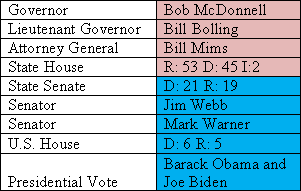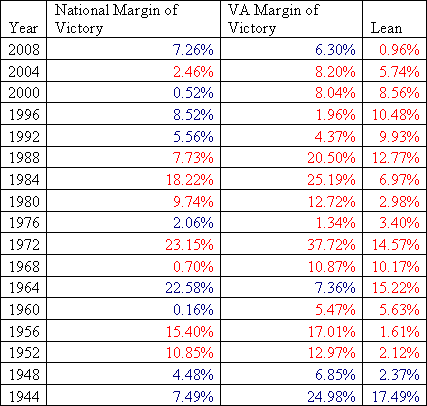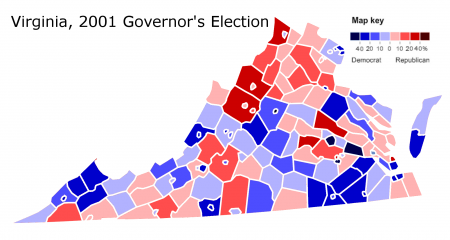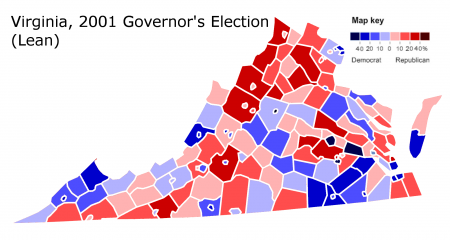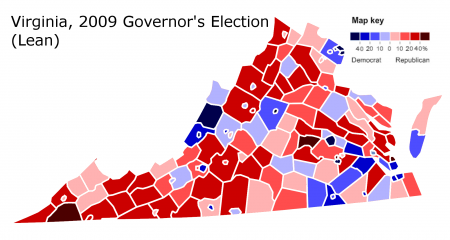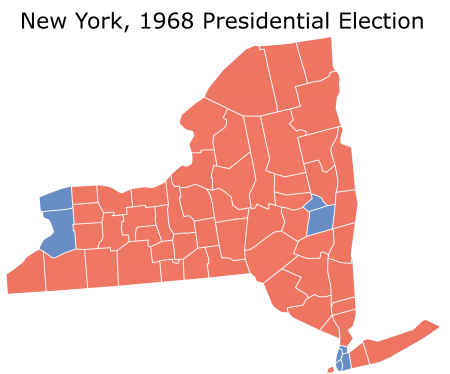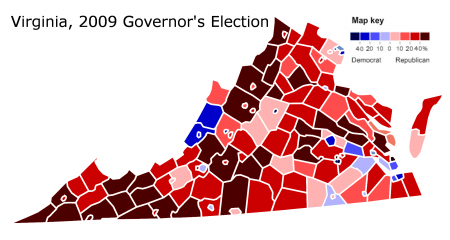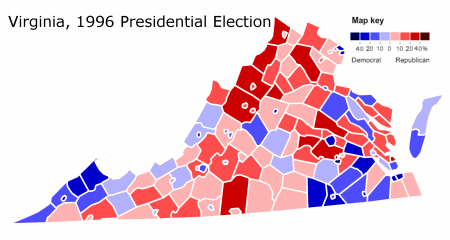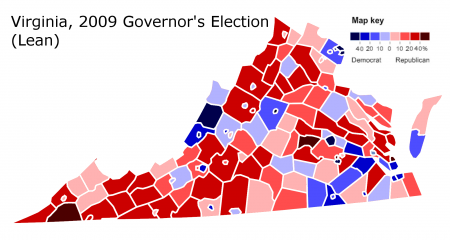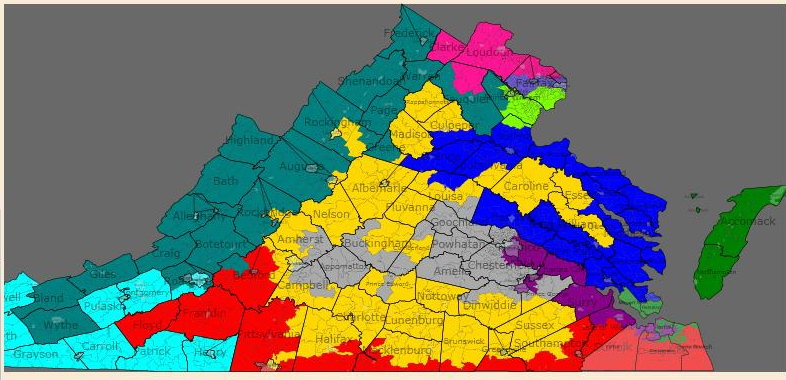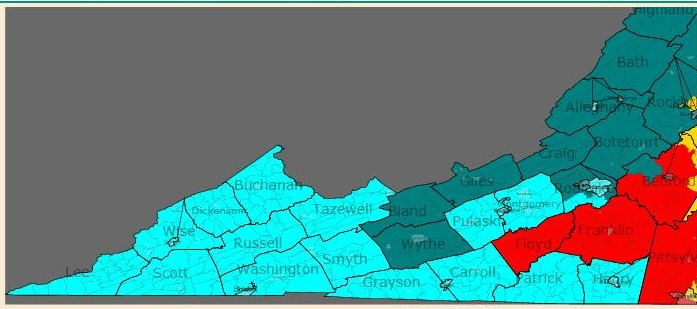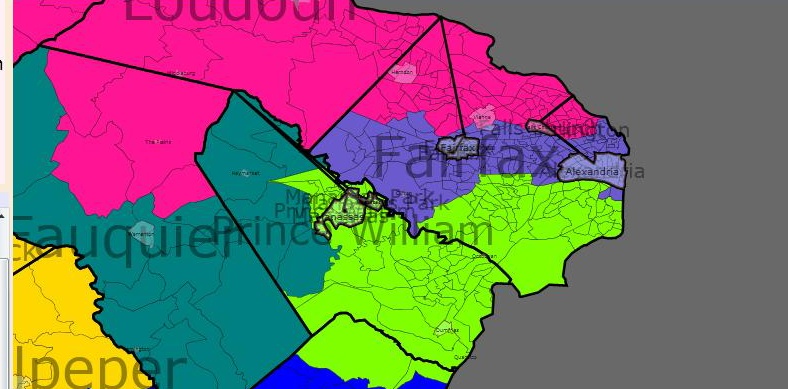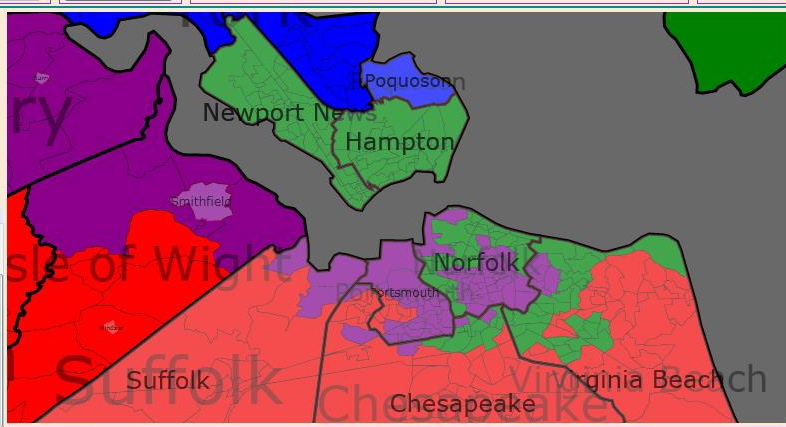Hey everyone, there haven’t been as many redistricting diaries lately, so I thought I’d make one for Virginia, since it’s a state that’s very close to home for me and has seen some big changes recently.
The first thing I did was I assigned all of the precincts in the state 4 colors (Blue for Obama over 56%, Green for Obama under 36%, Purple for McCain under 56%, and Red for McCain over 56%. I figure this would give a good visual representation of VA’s electorate and make things easier for me or anyone else.







This allowed me to do some stats on the entirety of all strong-Obama, weak-Obama, Strong McCain, and weak-McCain precincts in the entire state. Here’s what I came up with:
39.95% of all Virginians (or 3,104,205 people) live in precincts that went strongly for Obama.
13.73% of all Virginians (or 1,066,544 people) live in precincts that went weakly for Obama.
12.26% of all Virginians (or 952,461 people) live in precincts that went weakly for McCain.
34.06% of all Virginians (or 2,645,879 people) live in precincts that went strongly for McCain.
Aggregating votes using winner-take-all precincts gives Obama a win of 53.68%.
For strong Obama precincts, the racial stats were: 48% white, 31% black, 7% Asian, and 10% hispanic.
For weak Obama precincts, the racial stats were: 68% white, 15% black, 7% Asian, and 7% hispanic.
For weak McCain precincts, the racial stats were: 75% white, 14% black, 3% Asian, 4% hispanic.
For strong McCain precincts, the racial stats were: 85% white, 8% black, 1% Asian, 2% hispanic.
Now, since congressional districts are assigned based on precincts, I decided that the strong precincts represent the base number that a party should have. Thus, the Democrats should have 39% of the Congressional seats, and the Republicans 34%. The weak precincts in between represent the areas where manipulation through gerrymandering are most effective. Thus, if the Democrats controlled redistricting, a “safe” map for them to draw would consist of 7 Democratic seats and 4 Republican seats ((1-.3406)(11 districts))=7.25. The same goes for the Republicans, who are more likely to control redistricting ((1-.3995)(11 districts))=6.60. One could gerrymander beyond this, but not without introducing some serious partisan territory into their districts that could make them vulnerable down the road (as what happened to Republicans when they tried to pack all the Dems into 2 districts).
Therefore, I decided to draw a “safe” map that the Republicans would be smart to draw if safety is their greatest concern. I chose the Republicans because I’m not sure if the Dems will have a hand in this in VA come 2012. The outcome gives Republicans an additional 2 seats and would ensure that NO seats would change hands after the 2012 elections.
Here’s what I got:




District 1 – Blue – Rob Wittman (R)
Changes very little. Needs to expand more into NoVA due to population growth, but less than 10% of the district lives there. The NOVA part voted for Obama, but the rest of the district is fairly conservative. In fact, just to make sure, I traded some majority-black precincts and counties out for some of ultra-conservative Hanover County and other deep-red areas around Richmond. McCain probably got about 55% here. (71% white, 17% black, 2% asian, 6% hispanic)
District 2 – Green – Glenn Nye (D)
Changes greatly. Goes from being Virginia Beach and Eastern Shore based to being a liberal Hampton Roads district. I know some of you think that this district is unnecessary, but without it the Republicans would need to do some serious cracking, because there are still many majority-black precincts left over after packing VA-03 so much that it becomes 64% black (this is why Obama won Forbes’ district and almost won Nye’s). Obama probably got 65-75% here, as the district ONLY consists of strong Obama precincts. Nye would probably be challenged from the left by a black democrat in this district (39% white, 49% black, 3% Asian, 4% hispanic)
District 3 – Purple – Robert Scott (D)
Expands out into the countryside, into areas that helped Obama win Forbes’ district. I could’ve made it more black, but I wanted to keep the lines clean so that the courts couldn’t say anything. Still crosses the river, but not as obnoxiously as before. Obama probably got 65-75% here. (41% white, 50% black, 1% Asian, 5% hispanic)
District 4 – Red – Randy Forbes (R)
District becomes completely bleached and safe for anyone who succeeds Forbes in any political environment. Added the lean-Dem Eastern shore in so that the district isn’t too packed. McCain probably got 60% here. (72% white, 17% black, 3% Asian, 4% hispanic)
District 5 – yellow – No incumbent
Getting rid of Periello’s district was easy. I decided to break open Goodlatte’s and Boucher’s districts because they are overpacked with Republicans. This district takes in liberal areas in Roanoke, VA Tech, and Harrisonburg just to make VA-06 more conservative, but the district is still safe for any Republican who runs. McCain probably got 60% here. (82% white, 11% black, 1% Asian, 2% hispanic)
District 6 – teal – Bob Goodlatte (R) vs. Rick Boucher (D)
I know they worked out some kind of deal back in 2002, but if Republicans really want this seat, they really have no reason to care what Goodlatte thinks. This is mostly Goodlatte’s territory, but it takes in Boucher’s home. Goodlatte should win easily since nearly every precinct is strong-McCain. McCain probably got above 65% here. Republicans can unpack this after 2022 if they want. (91% white, 4% black, 1% hispanic)
District 7 – gray – Eric Cantor (R) vs. Tom Periello (D)
This district is anchored by the strongly-Republican Richmond suburbs. I took out some majority-black areas in Richmond, but I added some liberal areas in Charlottesville and majority-black areas from VA-01 to compensate. McCain’s performance is probably unchanged at 53%, but Cantor should be fine. I did not want to expand this district into NoVA, but I had to since I wanted to keep Wolf’s district partially in the Shenandoah Valley. Part of it was already in the DC media markey anyway. (77% white, 12% black, 4% Asian, 4% hispanic).
District 8 – purplish blue – Jim Moran (D)
Unpacked some to expand into heavily Obama areas in NoVa. Almost every precinct in this district was strong-Obama (he probably got 65% here). (59% white, 7% black, 14% Asian, 16% hispanic.
District 9 – light blue – No incumbent
Made this district too conservative for Boucher to win if he moved into it (he’d have to air ads in the Richmond suburbs where fire-breathing Republicans would hate him anyway). Really doesn’t include any liberal areas except maybe Danville. McCain probably got 60% here. (75% white, 19% black, 1% Asian, 3% hispanic)
District 10 – pink – Frank Wolf (R)
Wanted to keep one Republican district in NoVa. Basically trades Dem areas for Rep areas, while trying not to take in any strong-Obama precincts. Obama got 55% in Wolf’s current district, but I’d wager that drawn this way, the district would’ve went for McCain by about 52-53%. This is the only district that might change hands if the Dems haven’t peaked in NoVA, but given some recent elections there, I think they have. (76% white,
76% white, 6% black, 8% Asian, 7% hispanic).
District 11 – light green – Gerry Connolly (D)
Loses Republican areas, gains Democratic areas. It was hard for me to believe, but some of the Prince William County precincts went over 75% for Obama, and this was a district that was drawn for a Republican; well, there’s no way this one is going back to them anytime soon; thus, this is their second concession. (49% white, 17% black, 12% Asian, 18% hispanic), and yes, Virginia gets 3 minority-majority districts under this plan.
Whew, well, let me know what you all think of all this.
